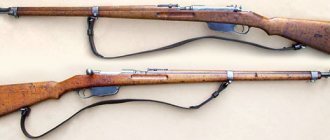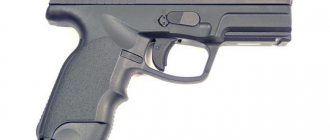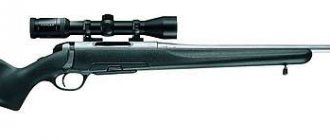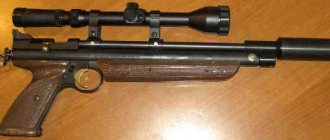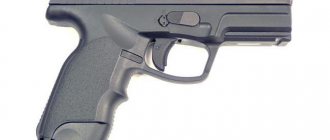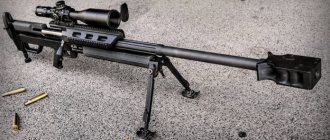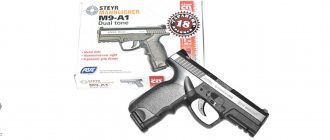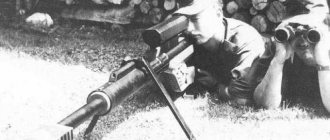Description:
The shutter is longitudinally sliding. USM with fuse. Middle integral magazine with a capacity of 5 rounds, with batch loading. Sights consist of a quadrant sight (400-1700, 1800-2500 - a distinctive feature from the model 1888-90), a triangular cross-section front sight on a base mounted on a ring in the muzzle of the barrel and a second, pointed, side front sight (for shooting for long distances up to 3000 steps), mounted on the middle stock ring.
The device is made of steel and consists of a trigger guard, which is part of the magazine body, a butt plate, three stock rings and two swivels. On the left side of the front stock ring there is a bracket for installing a bayonet, and at the bottom there is a rod (crutch) for making the rifle into a “goat”. The stock is wooden, solid. The neck of the butt is semi-pistol shaped.
Ammunition type 8 mm M.1888 scharfe Patrone. On the left side of the barrel chamber there is serial number 2042О, on top there is a test mark in the form of the letters “Wn”, “Habsburg eagle” and the number “?” (lost due to drilling of the barrel).
The designation is marked on the top of the receiver chamber. The buttstock on the left has serial number 2042O. The stamps “H”, “10”, “J” are applied to the lower part of the butt. On the right side of the stock there is a metal plate nailed with 4 nails with the engraved inscription “Trophy of the War of 1914-1918.” and the old museum number “AM 19” is applied.
Size: caliber 8 mm, barrel length 762 mm, total length 1280 mm, magazine capacity 5 rounds
Material: steel, wood.
Blaser R93 and Mannlicher SBS 96
Model: Blaser R93 Standart
” Caliber - .30-06 Sprg Barrel length, mm - 577 Weight, kg - 3.0 Total length, mm - 1002 Magazine capacity - 3+1 Price in Moscow, $ USA.
— 2940 (without optics) Manufacturer — Blaser Jagdwaffen GmbH This weapon appeared in the early 1990s and immediately attracted the attention of the shooting community with the boldness and unusualness of many technical solutions.
The main design discovery is, of course, the direct action bolt, which allows you to shoot from such a carbine almost as quickly as from a semi-automatic machine. Another important innovation was the modular design of the weapon. Thanks to the interchangeable barrel, magazine and bolt cylinder, the shooter can create any combination of calibers he needs on the basis of one rifle. The optical sight is mounted on the barrel, which allows it to be changed without additional sighting. The barrels are made using the cold forging method. Blaser R93 is available in several versions: Standard, Prestige, Luxus, Grand and Super Luxus, Royal, distinguished by the quality of finishing, the most lightweight Attache, Safari (for African hunting), JagdMatch (with a precision barrel), Offroad (plastic stock). Every year among our compatriots there is a growing interest in classic hunting rifles with manual reloading.
Hunters are especially drawn to such weapons. There are many reasons for this. Firstly, the greater reliability of such weapons, and secondly, the ability to use many calibers that are not available, say, in semi-automatic weapons. An important fact is that imported classic rifles are, to a large extent, high-quality weapons. For many people, such weapons are one of the ways to emphasize their social status, and Western manufacturers understand this, offering models of appropriate quality and price. Barrels of the tested carbines: Blaser R93 barrel on top, Mannlicher barrel on bottom.
For this test, we chose two carbines from the most famous Western European manufacturers: Blaser R93 and Mannlicher SBS 96.
In order to simplify the task of comparing these carbines, we decided to take the weapon in the basic configuration.
As for the caliber of the weapon, it was decided to go with .30-06 Sprg, since this cartridge, slightly superior to the domestic 7.62x54R in power, allows you to catch almost any game in the middle zone, with the possible exception of the largest animals.
We hold it in our hands
Blaser R93 looks very compact. Having placed the two tested carbines side by side, we even began to doubt: perhaps their barrels were of different lengths? Taking a tape measure in our hands, we checked: both carbines have a barrel length of 577 mm, but the total length differs by almost 70 mm! It's all about the Blaser's compact sliding bolt, which allowed us to save those extra centimeters.
Model - Mannlicher SBS 96
”Caliber - .30-06 Sprg Barrel length, mm - 577 Weight, kg - 3.5 Total length, mm - 1100 Magazine capacity 4+1 Price in Moscow, $US.- 3009 (without optics) Manufacturer - Steyr-Mannlicher
The carbine appeared in the mid-1960s and was modernized several times.
The latest modification, SBS 96, has an improved fuse system. The bolt has rear lugs, the handle rotation angle is 60 degrees. The magazine is replaceable, two-row. It is possible to install a rotary type magazine. The barrels are made by cold forging. The weapon comes in a variety of designs and calibers. Based on the Mannlicher hunting rifles, the SSG sniper rifle is produced. Although the “Standard” package provides for the absence of engraving and wood carving, “Blaser” looks very noble: the quality of the wood is very good, the metal processing is impeccable.
All metal surfaces are treated with a matte finish. Butts of the tested guns: on the left - Mannlicher, on the right - Blaser R93
If the “technogenic” motifs are clearly visible in the features of the “Blaser”, then the Mannlicher looks like the embodiment of a classic hunting weapon. Beautiful wood, precise fitting of parts. The metal parts look beautiful: the chrome-plated bolt and the twisted barrel, as if varnished, create a finished look. But this beauty in the bright rays of the sun can play a cruel joke on the owner of the weapon, betraying his presence to the beast.
The swivel mounted on the Mannlicher barrel caused our friendly misunderstanding (in the Blaser it is placed on the cut of the forend).
Both carbines have rubber butt pads.
The mounting of the optics is noticeably different. The Blaser has a mount located directly on the barrel. This is due to the modular design of the carbine: replacing the barrel along with the sight allows you to use the weapon without additional zeroing. The so-called saddle bracket provides a large mounting contact area, which increases the reliability of the installation of optics.
The Mannlicher mount is more traditional: it is a “bridge” installed on top of the receiver (receiver).
Swivel on the carbine: at the top - Blaser R93, at the bottom - Mannlicher
The safety of the "Blaser" is large, with a corrugated surface and marks showing its current condition, fixed on the rear surface of the bolt. The scheme of its operation is as follows: when it is placed in the “fire” position, the mainspring is simultaneously cocked. Thus, a weapon with the safety on is not cocked and cannot fire, which ensures maximum safety.
The Mannlicher safety is made in the form of a plastic wheel located on the neck of the butt. By rotating it up and down, it is removed or placed in the appropriate position.
The Blaser R93 magazine is detachable, single-row, made of plastic. It can be removed from the weapon if it is not completely disassembled. The carbine is loaded through the receiver window.
The Mannlicher magazine is detachable, with staggered cartridges, and can be removed by pressing two latches on the sides of the magazine. The back wall of the magazine is made of transparent plastic to control its filling.
Shooting
Reticle
Optical sights were installed on the weapon:
- Blaser R93 -Swarovski Habicht PV variable magnification 3-12x with Duplex reticle.
- Mannlicher SBS 96-Schmidt & Bender variable magnification 1.5-6x with Circle Dot reticle.
For the test we used Winchester Super-X cartridges with a semi-jacketed CXP2 bullet weighing 11.66 g. We chose semi-jacketed bullets in this case (although they are considered to be less accurate than fully jacketed bullets) because we decided to bring this closer test for real hunting conditions. After all, in fact, we are not testing rifles for precision shooting, but classic hunting carbines!
Shooting was carried out from a “sitting” position from a rest at a distance of 100 m at an atmospheric temperature of +10 ° C with two shooters in series of three shots (this is the nominal capacity of the Blaser R93 magazine, excluding the cartridge in the chamber).
The shooting results look very, very decent: to be honest, we did not expect to get such groups from an expensive, but still hunting, and not precision weapon. In addition, it is worth considering that the shooting was not carried out with the best, from a ballistics point of view, semi-jacketed bullets.
However, the Blaser R93's sub-1 MOA performance is nothing short of admirable.
With the Mannlicher SBS 96 we also managed to achieve quite decent results, an average of 1.2 MOA. But still worse than the Blaser R93.
There was no delay noted during the shooting.
The Mannlicher trigger has a trigger mechanism that works according to the traditional scheme: the trigger is pulled forward and the trigger is alert.
Schneller mechanism on the Mannlicher carbine
The approach is completely different: its designers believe that the trigger mechanism is a risk factor. Therefore, in all products of the company, it was decided to abandon it in favor of a precision trigger device, allowing a qualified shooter to achieve the best results.
The trigger action of both rifles is perfect: smooth and soft, with a clear click. Both triggers deserve top marks.
The recoil of both carbines turned out to be quite acceptable and is tolerated approximately the same as when shooting domestic 7.62x54R cartridges.
It is worth noting that for the Blaser R93 there are at least two additional devices (they were not included in the weapon presented for testing) that can further reduce recoil, which is especially important for “African” calibers. The first device is the “Mag-na-Port” muzzle brake, which consists of four slots near the muzzle. According to claims, using this option allows you to reduce returns by 20%. The second device is a cylinder weighing 600 g filled with tungsten granulate, placed in the butt of the carbine.
The Blaser's famous straight-action action really deserves praise: shooting from a carbine of this design is a pleasure and makes it comfortable. After each shot, the hand intuitively finds the handle and moves it back. In this case, you do not have to tear your head off the butt and change the position, which often affects the stability of hits. The shutter operates very smoothly and clearly. Sometimes it even seems like you are shooting from a semi-automatic machine.
The operation of the Mannlicher bolt contrasts sharply with this: despite the fact that the lifting angle of the bolt handle is only 60°, each time after a shot it was necessary to raise the head: firstly, in the rearmost position the bolt almost touches the face, and secondly, the moment of releasing the cartridge case requires very significant effort. The handle itself of this carbine was less liked than that of the Blaser. The latter has a pleasant to the touch and ergonomic round knob. We found the curved, polished Mannlicher bolt handle less comfortable.
The Mannlicher shutter itself is impeccably made: there are no backlashes, its movement is smooth. Perhaps in any other test it would have deserved the highest marks, but the Blaser's shutter simply captivated us.
conclusions
We got worthy opponents for the test - we realized that right away! However, our pick for today is the Blaser R93. At almost the same price as the Mannlicher, the Blaser has a number of significant advantages. Firstly, the accuracy of this weapon is better. Secondly, the modular design allows you to assemble, as if from a construction set, the rifle you need at the moment. This is true for many people who are used to traveling with weapons. In addition, such a design scheme will save you one, or even two “extra” licenses for the purchase of rifled weapons: a separate permit is not required for the barrel included with the carbine.
Thirdly, the compactness of the weapon - as we wrote above, the Blaser is slightly smaller in size than its opponent.
The Mannlicher is slightly inferior in terms of shooting accuracy and usability. The lack of interchangeable barrels limits its capabilities, but nevertheless, it is a good choice for people who value traditionalism in weapons.
For the first time in all the years of comparative tests, a weapon receives maximum scores, which confirms the validity of our statement that the Blaser R93 and Mannlicher SBS 96 are truly worthy rivals.
Alexander Kudryashov Nikolay Dergachev
